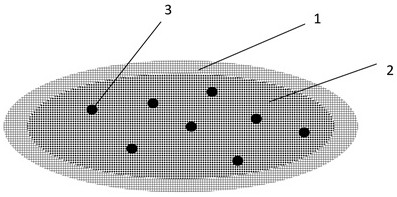an implant
A technology of implants and cells, which is applied in the field of implants, can solve the problems of good surface softness, and achieve the effect of facilitating tissue regeneration, good cell adhesion ability, and promoting regeneration
- Summary
- Abstract
- Description
- Claims
- Application Information
AI Technical Summary
Problems solved by technology
Method used
Image
Examples
Embodiment 1
[0059] Embodiment 1: An implant is composed of a cell adhesion layer 1 and a skeleton regeneration layer 2. The preparation method used for the cell adhesion layer 1 and the skeleton regeneration layer 2 is electrospinning, and what is prepared is: a cross-porous mesh structure, the fiber diameter of the network is 15±3um, and the stress is 486±3MPa; the skeleton regeneration layer 2 is a dense three-dimensional porous structure skeleton, in which extracellular matrix particles 3 are randomly distributed; the cell adhesion layer 1 and the skeleton regeneration The layer 2 is prepared separately, and the cell adhesion layer 1 completely wraps around the skeleton regeneration layer 2 to form the final implant. Its cross-sectional diagram is shown in the appendix figure 1 . When used as a urethral sling, it is processed into a long strip; when used as a pelvic floor organ sling, it is processed into a butterfly shape. The specific process is: according to the mass fraction, add...
Embodiment 2
[0060] Example 2: An implant, one side is a cell adhesion layer 1, and the other side is a skeleton regeneration layer 2, which is prepared by continuous electrospinning. What is prepared is: sandwich structure, the first layer is cross-porous The network structure, the fiber diameter of the network is 15±3um, the stress is 486±3MPa; the second layer is also a cross-porous network structure, and the angle between it and the fibers of the first layer is 45°, and the fiber diameter of the network is 47±6um, the stress is 348±2MPa; the third layer of skeleton regeneration layer 2 is a layer of dense three-dimensional porous structure skeleton, in which extracellular matrix particles 3 are randomly distributed; the three-layer structure is integrally spun and formed, and its cross-sectional diagram is shown in attached figure 2 . The specific preparation process is: according to the mass fraction, add 60% silk fibroin, add 20% extracellular matrix, and perform dry spinning with ...
Embodiment 3
[0061] Embodiment 3: An implant is integrally processed. The difference from Embodiment 2 is that the guided regeneration of cells is considered. In the skeleton regeneration layer 2, the concentration of the extracellular matrix is distributed in a gradient. According to the mass fraction, add 60% silk fibroin, add 20% extracellular matrix, dry spinning with water as a solvent to obtain a thin fiber layer, the fiber diameter of the thin fiber layer is between 15±3um, which is cross-network Structure; according to the mass fraction, add 20% silk fibroin, add 35% extracellular matrix, use water as a solvent, and use ammonium sulfate aqueous solution as a coagulation bath to carry out wet spinning on the basis of the thin fiber layer to obtain The thick fiber layer, the fiber diameter of the thick fiber layer is between 47 ± 6um, which is a cross network structure; according to the mass fraction, 70% poly-L-lactic acid and 20% extracellular matrix are dissolved in a solvent for...
PUM
 Login to View More
Login to View More Abstract
Description
Claims
Application Information
 Login to View More
Login to View More - R&D
- Intellectual Property
- Life Sciences
- Materials
- Tech Scout
- Unparalleled Data Quality
- Higher Quality Content
- 60% Fewer Hallucinations
Browse by: Latest US Patents, China's latest patents, Technical Efficacy Thesaurus, Application Domain, Technology Topic, Popular Technical Reports.
© 2025 PatSnap. All rights reserved.Legal|Privacy policy|Modern Slavery Act Transparency Statement|Sitemap|About US| Contact US: help@patsnap.com



